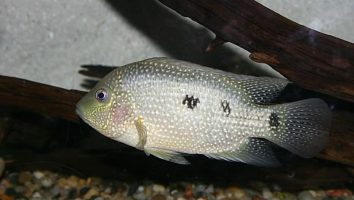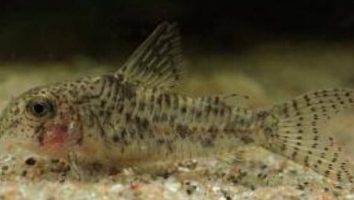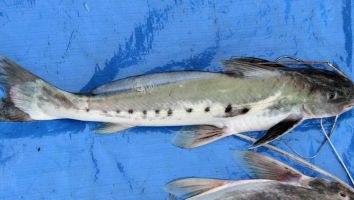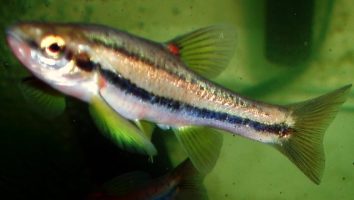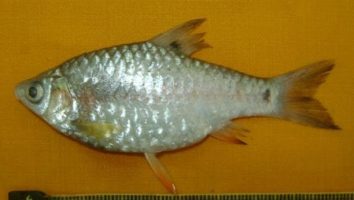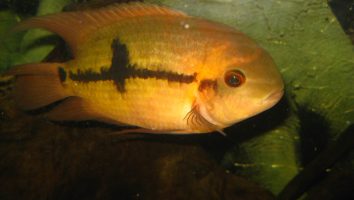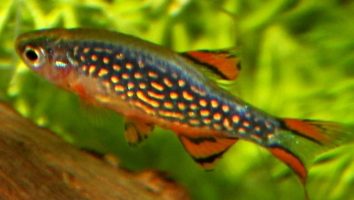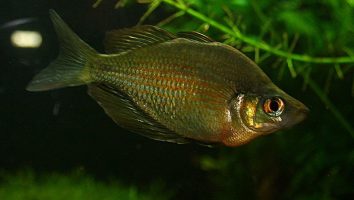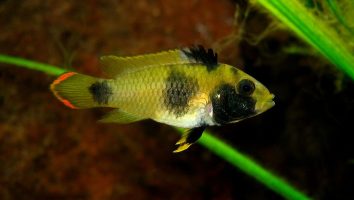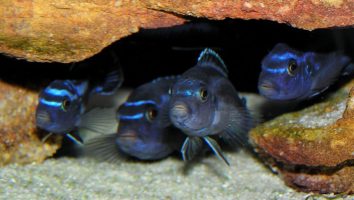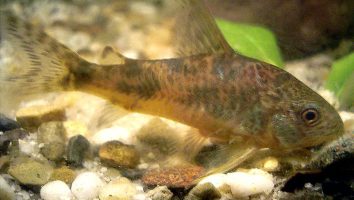Boeseman’s rainbowfish is a beautiful and peaceful freshwater fish that is perfect for beginners. They are easy to care for and can live in a wide range of tank conditions.
This guide will teach you everything you need to know about Boeseman’s rainbowfish care. You’ll learn about their diet, size, lifespan, and more!
Table of contents
Species overview
Boeseman’s rainbowfish (Melanotaenia boesemani) are native to freshwaters in Indonesia and Papua New Guinea.
They prefer slow-moving rivers and streams with a lot of vegetation. This provides them with the cover they need from predators as well as a plentiful food source in the form of small insects and crustaceans.
Boeseman’s rainbowfish are very peaceful fish that do well in community tanks. They are known for being particularly good at getting along with other rainbowfish species.
The main attraction of Boeseman’s rainbowfish is their bright coloration. The males in particular are very vibrant, with blue and green bodies and bright red fins.
Appearance
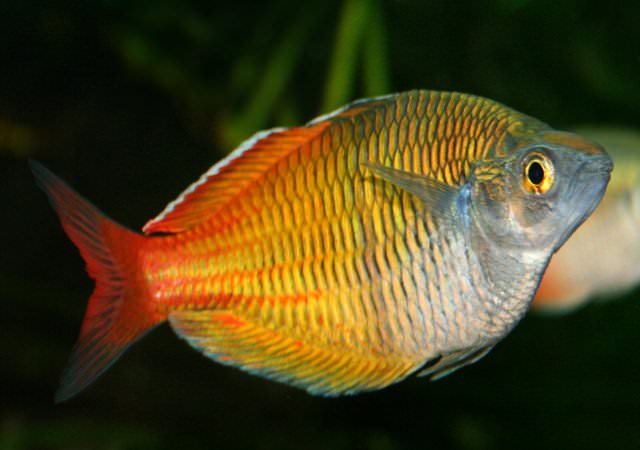
The Boeseman’s Rainbowfish is one of the more popular freshwater fish in the aquarium trade. This is due to their unique and vibrant coloration.
As the name implies, these fish have a lot of rainbow colors going on. The main body color is a steel blue. However, you’ll also find bright yellow, orange, and red accents all over their body. The fins are usually translucent with a bit of blue.
Males tend to be more colorful than females. However, both sexes are still quite beautiful to look at.
Boeseman’s Rainbowfish have a long and slender body shape. They’re quite tall as well, which gives them a very elegant look.
Their fins are all moderate in size. The dorsal fin is positioned about two-thirds of the way back on their body. It’s slightly rounded and has 12-17 soft rays.
The anal fin has a similar shape but only has 3-5 soft rays. Both of these fins are slightly taller than their caudal fin, which is forked.
The pectoral fins are long and pointed. They start just behind the gill covers and extend back to about the middle of the fish.
Lifespan
The average lifespan of Boeseman’s rainbowfish is around 5 years. However, there are a number of factors that can impact their lifespan.
If these fish are kept in captivity, they usually don’t live as long as they would in the wild. This is because they’re more susceptible to disease and stress in captivity.
The level of care they receive also matters a great deal. If they’re kept in a well-maintained tank with optimal conditions, they’ll usually live longer than if they’re kept in suboptimal conditions.
Size
Boeseman’s rainbowfish are a relatively small species of fish, only growing to be about 2-3 inches in length.
Tank
Tank Size
The recommended tank size for Boeseman’s rainbowfish is at least 50 gallons. If you want to keep more than one fish, you should add at least 20 gallons for each additional fish. These fish are active swimmers and need plenty of space to move around.
Water Parameters
Boeseman’s rainbowfish are a tropical fish that come from the fresh waters of Indonesia. In the wild, they inhabit slow-moving streams and rivers with plenty of vegetation.
To recreate this in the home aquarium, you’ll need to maintain similar water conditions. Boeseman’s rainbowfish are a bit more sensitive than some other tropical fish, so it’s important to keep water quality high.
Here are a few key water parameters to remember when caring for Boeseman’s rainbowfish.
- Water temperature: 77 to 86 degrees Fahrenheit
- pH levels: 6.8 to 7.6
- Water hardness: 4 to 12 dGH
- Alkalinity Levels: 2-8 dKH
What To Put In Their Tank
These fish come from slow-moving rivers and streams in Indonesia. As a result, they’re not used to a lot of movement in their environment.
Because of this, you’ll want to avoid anything that creates a lot of water movement in their tank. This means no powerful filters and no bubbling decorations.
The inside of their tank should be set up in a way that replicates their natural habitat as much as possible. This means a lot of plants and some driftwood for them to hide behind.
A sandy substrate is a good choice since it replicates the river beds they’re used to. Just make sure there aren’t any sharp objects that could hurt them!
These fish are known to be jumpers, so a tight-fitting lid is a must.
Common Diseases
There are a few diseases that you need to watch out for when you’re keeping Boeseman’s rainbowfish. The most common one is ich, which is a parasite that can affect any freshwater fish.
This will show itself as white spots on the body, fish, and gills of your fish. We won’t do a full ich treatment guide here (there are plenty of those online) but it’s something you need to take very seriously if it affects your Boeseman’s rainbowfish.
The other disease you need to be aware of is hole-in-the-head disease. This is a rather gruesome looking illness that stems from poor water quality and the presence of activated carbon in your tank.
This will present itself as one or two pits/holes in the skin of your fish’s head. While it’s almost always curable (fixing your water quality and removing activated carbon is usually all you need to do), it will usually leave some scarring on your poor fish!
As always, the best way to prevent these diseases is to maintain a clean and healthy tank. Keep the water quality high, do regular water changes, and don’t overstock your tank.
By doing these things you’ll create a much healthier environment for your fish and significantly reduce the risk of them getting sick.
Behavior & Temperament
Boeseman’s rainbowfish are peaceful fish that do well in community tanks. They are shy fish that prefer to stay in groups. When they are comfortable, they will be out in the open more often.
Boeseman’s rainbowfish are active fish that enjoy swimming in planted tanks. They are not aggressive and get along well with other fish. They may nip at fins, but this is usually not an issue.
Tank Mates
Boeseman’s rainbowfish are peaceful community fish that get along well with other fish, as long as they are of a similar size. They are not aggressive and are not known to nip at the fins of other fish.
Some good tank mates for Boeseman’s rainbowfish include:
- Tetras
- Danios
- Rasboras
- Gouramis
- Other peaceful rainbowfish
Breeding
Boeseman’s rainbowfish are not the easiest fish to breed in captivity, but it is possible with some patience and knowledge. These fish are typically found in slow-moving, murky waters in the wild.
To breed Boeseman’s rainbowfish, you’ll need to set up a tank that replicates their natural environment as closely as possible. The tank should be at least 30 gallons and have a dark substrate. Plants are not necessary, but you can add a few if you’d like.
The water temperature should be between 76 and 84 degrees Fahrenheit. The pH should be between 6.5 and 7.5, and the water should be on the softer side.
When setting up the tank, it’s important to create hiding places. These fish like to have a lot of places to hide, so use rocks, driftwood, and plants to create a labyrinth.
Once the tank is set up, it’s time to add the fish. It’s best to add a group of six or more fish. This will increase the chances of breeding.
Boeseman’s rainbowfish are not picky eaters. They’ll eat just about anything you give them. However, it’s best to feed them a diet that’s high in protein. This will help to bring out their colors and encourage breeding.
To trigger spawning, you’ll need to make a few changes to the tank. First, raise the water temperature to 86 degrees Fahrenheit. Then, do a large water change (about 50%).
These changes should trigger spawning. You’ll know it’s happening when you see the males chasing the females and guarding their eggs.
Once the eggs have been laid, remove the adults from the tank. The eggs will hatch in about 10 days.
When the fry hatch, they’ll need to be fed small live foods. Baby brine shrimp and microworms are a good choice. As they grow, you can start to feed them larger live foods and flakes.
Conclusion
Boeseman’s Rainbowfish are an absolutely stunning freshwater fish. They are known for their vibrant colors and patterns, which can really brighten up a tank.
They are a relatively easy fish to care for, although they do require a bit more attention than some other species.
Overall, we think they are a great option for anyone looking to add some color to their tank. Just be sure to do your research and be prepared to care for them properly.

